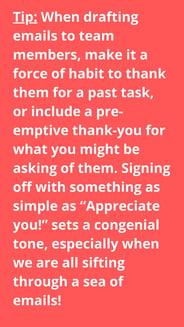Differentiate your employer brand to attract and keep an engaged workforce
- Consistency in message – and actions – is key
- Be authentic – you have to engage in your own program to make it contagious
Celebrate your employee’s life events - nice touch. A surprise gift card in the mail – once – will be remembered for a bit. Neither, though, will be the reason why someone takes a job, or stays in their job.
Don’t misunderstand; nice gestures are always welcomed. However, they will never replace authentic interest in employees and supporting them in a way that counts for them, consistently.
 Rewards and recognition at its foundation is about building a consistent culture that thrives on
Rewards and recognition at its foundation is about building a consistent culture that thrives on
appreciating your team, supporting their growth and being genuinely happy with their efforts and their success – all the time.
Recognition needs to be part of the company mindset, and it also needs to be deliberate and if deliberate means planning, then a good plan is the place to start:
1. Brand your Rewards and Recognition Initiative to Resonate Throughout Your Organization
Name your program to make it recognizable to both job seekers and customers and build a leadership team around it so that someone is always focused on its implementation and growth.
Weave program tenets throughout internal and external marketing, recruiting, operations and even sales efforts to ensure all employees and potential employees know it exists and can participate. This includes promoting through social media, including in printed literature, incorporating into job posts, interviews and even sales materials to show prospects the type of company you are.
 2. Instill behaviors in managers to insure timely recognition
2. Instill behaviors in managers to insure timely recognition
While it should be second-nature to say ‘thank you’ and to show appreciation for team members, it can’t hurt to set reminders to ensure that you do it! Here’s how to ensure you engage in your R&R program in the workplace:
- Setting up a Recognition Reminder to-do list should be a task assigned to all team members. It should be part of the onboarding process for new employees as well. Plan out when you will recognize someone – it doesn’t take away from spontaneity; it reinforces that employees and managers should make the time to do it.
- Program managers can distribute company-wide daily or weekly emails or texts encouraging employees to thank someone today.
- Require that all meetings, both in-person and online, include a short opening for a few minutes to recognize achievements or a milestone of anyone in the company (even if they are not in the meeting.)
- Using a social recognition program allows employees and managers to schedule announcements of recognition ahead of time when there is something important on the calendar for colleagues. A big sales presentation coming up? A note of “good luck – we know you can do it” is a great motivator amongst the stress!
- On-the-spot recognition certifications are inherently impromptu. However, when you plan to sit down each Thursday morning and fill out 10 on-the-spots for team members that week, you have set a goal to meet and it becomes part of a routine.
3. Leadership and managers must set the tone for creating a culture of recognition
President Teddy Roosevelt is famous for knowing every employee in the White House by their name, even after his term as the serving president.
Why share that story? Because it’s incredibly impactful. If the President of the United States can see fit to make that sort of effort, leadership and employees in all companies can strive to do the same. It may just be a greeting, but it is often well-received, when according to Gallup, 24% of employees say that their most memorable recognition came from the CEO.
Plus, when it comes from the CEO, it creates a trickle-down effect, permeating through departments. In fact, in one study,
- 88% of respondents found praise from managers very or extremely motivating; (Psychology Today). Studies also show that peer recognition is a key driver for performance.

Psychologists note it’s human nature to want to be appreciated and recognized. How we do that for each individual needs to be considered, though, which brings us to our next point.
4. Recognize individualism when you reward and recognize your team members
This includes lavishing public praise versus subtle notes of thanks.
The manager is this article raises a good point: what if some folks just don’t require recognition to do their job? Or more importantly, what if public commentary on their work is a dreadful experience? Again, being a great place to work takes into account all personality types. Some employees would love to be in the spotlight for a job well done; others might want to hide under the table. Still others may need a higher level of recognition to motivate them, while some might not even notice. This author notes it’s important to find the “goldilocks” of a happy medium in directing recognition in the workplace, especially publicly, which is something good managers will consider.
5. Rewards should reflect what employees like
If you don’t know what they like, ASK!
 We’ve all seen the picture of a teacher’s space OVERFLOWING with mugs? Thankfully, a brilliant PTO president somewhere had the ingenious idea of requesting their teachers create a favorites list each year. This tool has proven invaluably helpful during Teacher Appreciation Week. Seriously, who knew that some teachers might not even DRINK COFFEE?
We’ve all seen the picture of a teacher’s space OVERFLOWING with mugs? Thankfully, a brilliant PTO president somewhere had the ingenious idea of requesting their teachers create a favorites list each year. This tool has proven invaluably helpful during Teacher Appreciation Week. Seriously, who knew that some teachers might not even DRINK COFFEE?
(Credit: Hannah Hudson, weareteachers.com, 2018)
Yes, of course, it is the thought that counts and teachers everywhere will keep those mugs forever because it represents the children they have loved at their jobs. However, as an organization allocating hard-earned dollars to an important program designed to show appreciation to your team members, spend that budget on what you know your employees may need or want. Consider this:
- “66% of those surveyed said that receiving two tickets to a concert of their choice would make them feel loved, compared with 34% who favoured having three times the value of those tickets being paid into their paycheck over the course of a year.” (Xexec survey)
That’s significant and evidence that our efforts in rewards and recognition need to be relevant to the recipient.
Rewards and Recognition is a deliberate effort
It certainly seems like a lot of effort to find ways to motivate and engage your workforce. But time and again, we’ve found that making engagement and motivation as priorities is worth it. Statistically, you can’t argue when you look at the facts:
- “…a study of 1,500 respondents showed that disengaged employees cost companies between $450 and $550 billion a year.”(Joint study from The Engagement Group - a collaboration of The Conference Board, Sirota-Mercer, Deloitte, ROI, The Culture Works and Consulting LLP)
- “…in a three-year study of 41 global companies, we found that operating margins improved nearly 4% on average in organizations with high employee engagement levels and declined about 2% in those with lower engagement levels.” (Willis Towers Watson)
- Companies that invest in employee experience outperform companies that don’t in average revenue by 1.5 times, revenue per employee by 2.8 times, profit per employee by 4.0 time, and more. (Wellable)
Plus, a recent Gallup survey noted:
If companies double the number of employees they recognize every week, there will be:
- 24% improvement in work quality
- 27% reduction in absenteeism
- 10% reduction in staff shrinkage
All the above points to organizational success when teams feel seen and appreciated. But aside from business goals, perhaps the most important statistic lies here:




